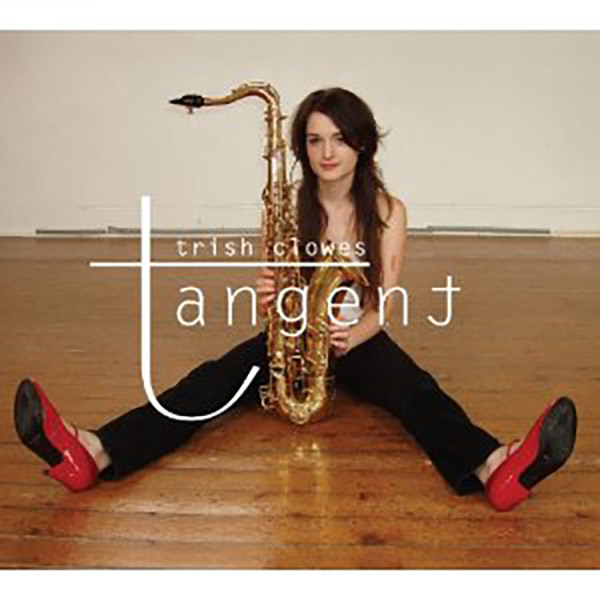
by Ian Mann
February 10, 2011
/ ALBUM
There's more than enough here to suggest that we'll be hearing a lot more from Trish Clowes.
Trish Clowes
“Tangent”
(Basho Records SRCD 33-2)
Trish Clowes (born 1984) is a young tenor saxophonist and composer from Shrewsbury who is now based in London following the completion of her studies at the Royal Academy of Music. Her teachers have included the saxophonist Iain Ballamy and the composer Hans Koller and her music has also won the endorsement of the much acclaimed pianist Gwilym Simcock who makes a couple of guest appearances and also acts as producer on this, Clowes’ début album.
Tangent is also the name of Clowes’ regular sextet but “Tangent” the album goes far beyond small group jazz to also feature Clowes’ writing for strings, full orchestra and voice. She likes to experiment with music that lies beyond the jazz idiom including tango, string quartet music, poem setting and writing for children. It is perhaps then not surprising that Clowes’ first recording should be so ambitious and wide ranging, if a little lacking in overall coherence.
The centre piece of the album is “Sketch” which incorporates a full orchestra directed by Jules Buckley and features a guest appearance by the aforementioned Simcock. However the album begins with the brief “Prelude To A Sketch”, the title an obvious nod to Duke Ellington, which features strings and French horn alongside more orthodox jazz instrumentation including Simcock at the piano.
The following “Search” features a sextet that includes pianist Huw White, guitarist Chris Montague, bassist Calum Gourlay and drummer James Maddren. These four highly talented young musicians have all featured extensively on this site as members of other bands and, in essence, they form the core group on this record. Here they are augmented by the cello of Heidi Parsons, a reflection of Clowes’ fascination with string sounds. Parsons adds a distinctive melancholy edge to this excellent small group jazz performance. The main soloist is Clowes herself with a warm but incisive tone that others have compared to Stan Getz and Bobby Wellins. She is followed by guitarist Chris Montague and it’s interesting to hear him in a more obviously jazzy context than with his own band Troyka. The superlative rhythm pairing of Gourlay and Maddren, most notably associated with the Kit Downes Trio, also get to show their abilities with Gourlay’s huge tone particularly notable.
Clowes doesn’t even appear on “Chalk”, a brief snippet of spiky free improvisation by White, Montague, Maddren and Gourlay on arco bass.
“Sketch”, the first of two pieces featuring Buckley and the orchestra opens quietly with Clowes and Simcock prominent. These two remain the dominant voices but they are augmented by the colourful and diverse orchestral arrangement which skilfully blends strings and horns and keeps well on the right side of cloying. This is classy and ambitious stuff.
Clowes also integrates string sounds into “Dreamer”, the next small group performance. Parsons, a regular member of the Tangent sextet is on cello with Triona Milne guesting on viola. Trumpeter Nick Smart comes in for Montague and the blend of horns and strings works well, a good synthesis between jazz and contemporary classical music. There’s an extended, but atmospheric, solo drum feature for Maddren mid tune before the rest of this unusual septet come back in with further features from White, Gourlay and Clowes.
“Duet” is another brief improvised passage, this time between Clowes and trumpeter Nick Smart, an absorbing display of interlocking contrapuntal horns.
The improvised “Blues For Frisell” homages Bill with Clowes and Montague engaging in a lengthy opening dialogue before being joined by Smart, Gourlay, Maddren and White. Horns carouse and guitars needle above Maddren’s skittering grooves, at times it almost sounds composed.
“The Master and Margarita” features the remarkably agile cello playing of Louise McMonagle alongside Clowes, Gourlay, Maddren and trumpeter Freddie Gavita. The way the two horns intertwine with the cello is particularly impressive with Gourlay and Maddren providing their customarily flexible and intelligent support. I would hazard a guess that there’s a fair degree of improvisation going on here with McMonagle, Gavita and Clowes in extremely impressive form. The piece also includes another extended feature from the excellent Maddren.
To close “Coloured Eye” sets a poem by Jessie Jones to music, the words sung by the clear and emotive voice of Kathleen Willison who also delivers a lengthy scat interlude. The orchestra, directed by Buckley also features but in a slightly more low key way than on “Sketch”. Clowes ’ warm, soaring solo explores the upper registers of her instrument with Montague, Gourlay, White and Maddren providing sympathetic support.
The sheer breadth of ambition displayed on “Tangent” makes it almost impossible for the record to cohere as an album. There are some excellent moments here and the playing by all concerned is exemplary throughout but for me it’s all rather too fragmented to make for truly rewarding listening.
Having said that I’d relish the opportunity to see Tangent, the group, in a live context. The small group pieces with cello are particularly intriguing and as a regular jazz listener I’d rate these the best on the album. Orchestral jazz doesn’t really work for me, even when it’s done as skilfully as here.
For all this “Tangent” is a good calling card for Trish Clowes, encompassing as it does all aspects of her talents. It’s admirable in its ambition and scope and it’s obvious that this is a young lady determined to find her own niche in the jazz firmament. There’s more than enough here to suggest that we’ll be hearing a lot more from Trish Clowes.
blog comments powered by Disqus